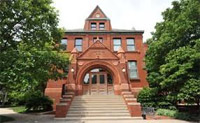Architecture, College of

Masters in Architecture Program: Theses
First Advisor
Rumiko Handa
Date of this Version
5-2022
Document Type
Thesis
Abstract
I have observed that architecture is not sufficiently understood. This problem is largely due to the fact that the language used to describe architecture is broad and convoluted. This language is also divided into two categories which describe the denotative and connotative nature of architecture. It is easier to understand the denotative nature of architecture than it is to understand the connotative nature. As a response to this issue, my project aims to explore the connotative nature of architecture through telling stories about the home from the architecture’s point of view. The purpose of my thesis is to explore the language of the connotative nature of architecture
This is accomplished first by identifying the mode of communication which is both the simulacrum and storytelling. From there, they are broken down into three sub-concepts: poesies, quotidian, and verstehen. Each of these sub-concepts inhabit an important role in this project; poesies - the poetic image and text; quotidian - the house; verstehen - Andrew Wyeth’s watercolors.
The simulacrum is made up of three spaces of the home: the sitting room, the kitchen, and the bedroom. These spaces are inspired by various paintings by Wyeth and have accompanying stories. This project aims to explore the connotative nature of architecture, while continuing to acknowledge the denotative nature, in order to strengthen the understanding of the architectural language in its entirety.


Comments
A design thesis Presented to the Faculty of The College of Architecture at the University of Nebraska In Partial Fulfillment of Requirements For the Degree of Master of Architecture, Major: Architecture, Under the Supervision of Professor Rumiko Handa. Lincoln, Nebraska: May 2022.
Copyright © 2022 Madeleine Pollara